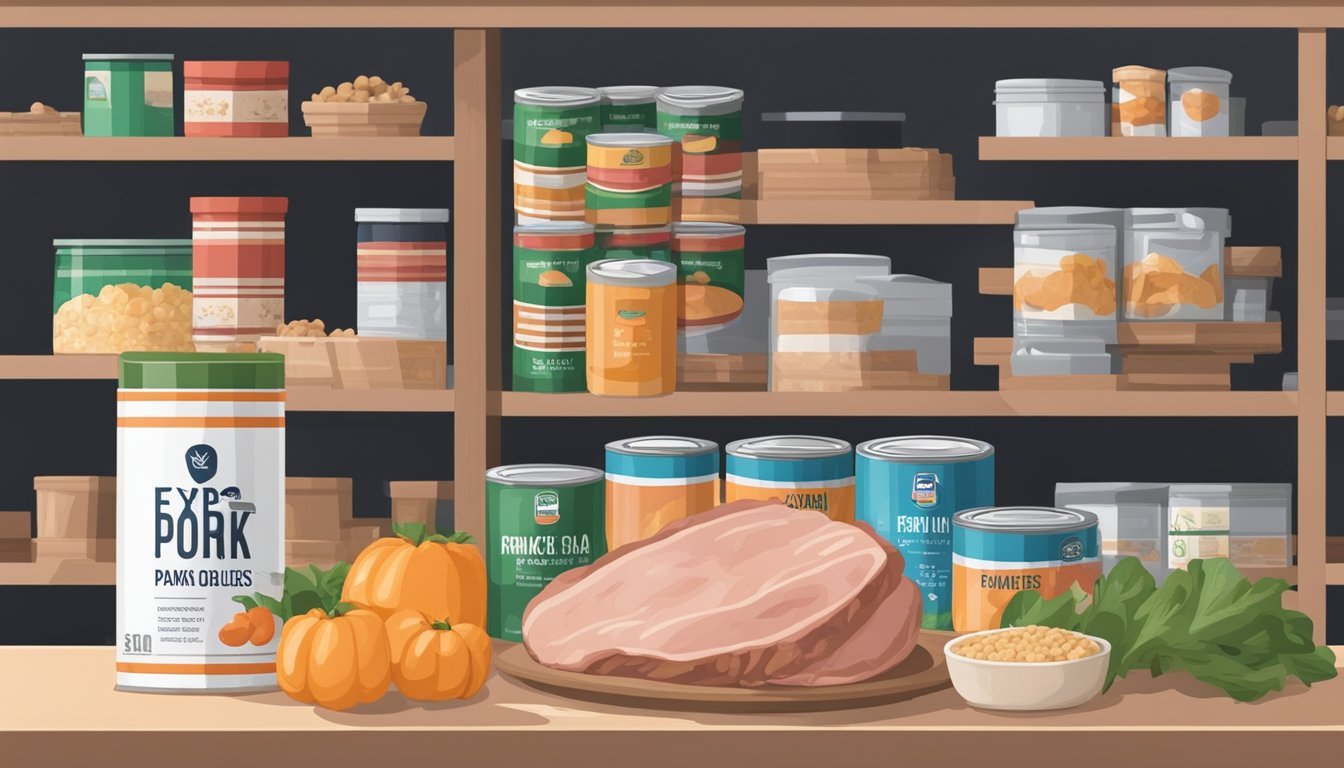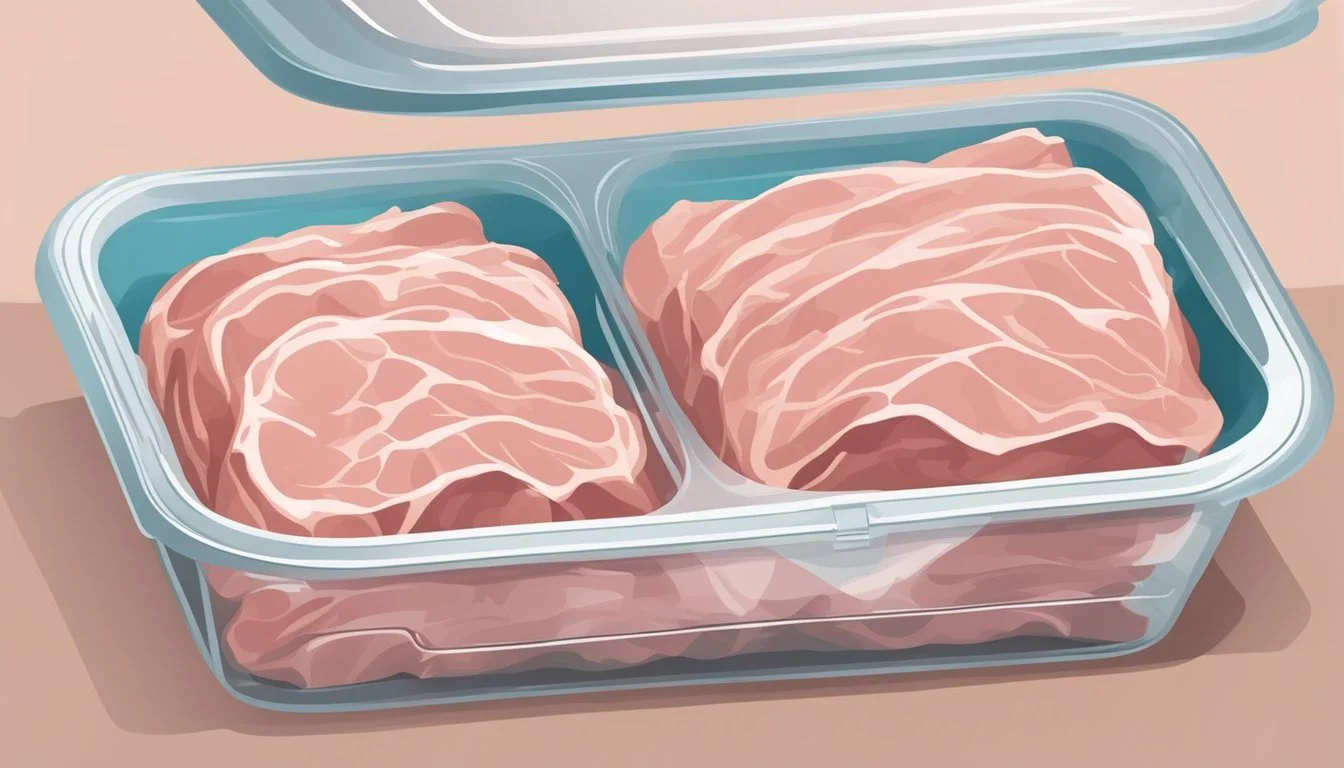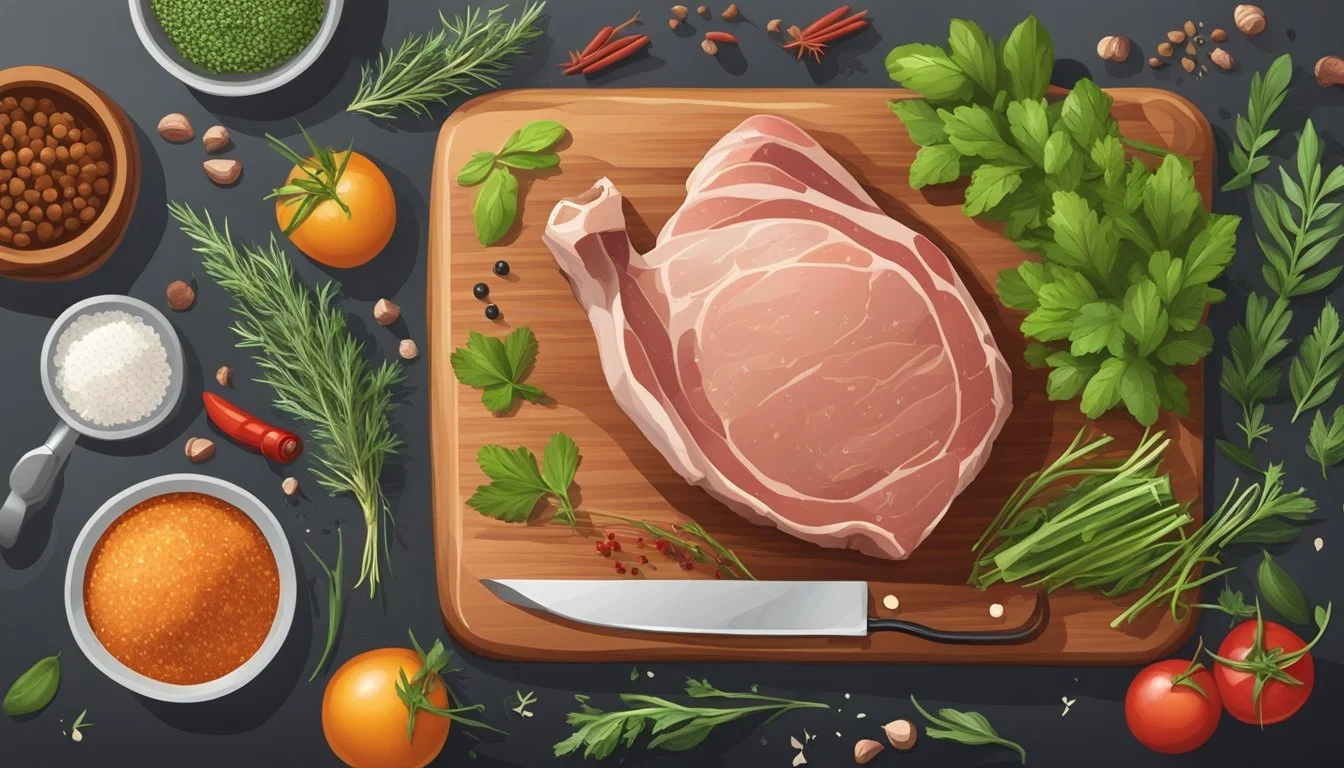How Long Does Pork Last?
Shelf Life and Storage Tips
The shelf life of pork varies depending on whether it is raw or cooked and the storage conditions. In the refrigerator, raw pork chops (What wine goes well with pork chops?) typically remain safe for consumption for 3 to 5 days if they are kept at a constant temperature of 40° F (4° C) or lower. Ground pork is more perishable, with a recommended fridge storage time of 1 to 2 days. It should be noted these time frames assume the meat is packaged and sealed properly in the cooler part of the refrigerator.
Once cooked, pork dishes should be consumed within 3 to 4 days when stored in the fridge. To ensure safety, leftovers should be refrigerated within two hours of cooking, and they should be kept in shallow, covered containers to cool uniformly. Freezing offers an extended storage solution, where pork can maintain its quality for up to six months. However, for optimum taste, it is advisable to use the frozen pork within the first few months of freezing.
Consuming pork past these time frames isn't recommended as it can compromise food safety. While some cuts of pork might have a sell-by date, this is more of an indicator for retailers rather than a concrete expiration date. Still, when storing pork, it's crucial to monitor the temperature and use proper containers to avert potential foodborne illnesses.
Understanding Pork Shelf Life
Proper storage and awareness of freshness indicators are crucial for maintaining the safety and quality of pork. Knowing the shelf life of various pork cuts and observing changes in color and texture help consumers enjoy pork at its best.
Determining Pork Freshness
Consumers should look for a grayish-pink color and avoid pork that appears discolored or has a slimy texture, which indicates spoilage. Marbling, or the white streaks of fat within the meat, can contribute to both the flavor and appearance of fresh pork. Signs such as an unpleasant odor, changes in color, or the presence of mold also serve as indicators that pork is no longer safe to consume. Consumers must remember that pork is an excellent source of protein and zinc, but its nutritional value can degrade if the meat is not fresh or adequately stored.
Shelf Life of Different Pork Cuts
The shelf life of pork depends on the cut and whether it's cooked or raw. A simple reference table can help:
Pork Cut Refrigerated Raw Frozen Raw Refrigerated Cooked Frozen Cooked Pork Chops 3-5 days 4-6 months 3-4 days up to 3 months Ground Pork 1-2 days 3-4 months 3-4 days up to 3 months Large Roasts 4-5 days 4-12 months 3-4 days up to 3 months
Expiration dates should be checked when purchasing pork; however, if stored properly, pork can sometimes be safe to consume after the sell-by date, although its quality might diminish. Consumers are advised to freeze pork if they do not plan to use it within the recommended time frame for refrigeration.
Storage Fundamentals
Effective storage of pork is crucial for maintaining its quality and safety. The fundamental aspects of pork storage include employing appropriate techniques, ensuring optimal temperature conditions, and using suitable materials to protect the meat from contamination and freezer burn.
Proper Storage Techniques
To store pork correctly, one should use moisture-resistant materials such as plastic wrap, aluminum foil, or freezer bags. For pork chops and patties, a double layer of waxed paper is recommended to prevent them from sticking together. Sharp bones should be covered with extra paper to avoid puncturing the wrapping. The pork must be wrapped tightly to expel as much air as possible, which helps to prevent freezer burn.
Temperature and Storage Conditions
The refrigerator's temperature should be set at or below 40°F (4.4°C) to safely store pork. Cooked pork needs to be refrigerated within two hours of cooking, or within one hour if the environment's temperature exceeds 90°F (32.2°C). In the freezer, pork should be kept at 0°F (-18°C) or lower. To ensure freshness and quality, cooked pork dishes are best used within 3 to 4 days when refrigerated and within 3 months when frozen.
Packing and Protecting Pork
When freezing pork, one should use airtight containers or freezer-safe containers to protect the meat. The meat should be removed from the bone and any excess moisture patted dry before packing it to avoid ice crystal formation. Label the container or wrap with the name of the pork cut and the date of freezing to keep track of freshness. Reheating cooked pork should be done until it reaches an internal temperature of 165°F (73.9°C) for safety.
Safety and Health Considerations
When it comes to pork, ensuring its safety and edibility is paramount. Consumers must focus on preventing foodborne illness through proper handling and be adept at recognizing the signs of spoilage to mitigate health risks.
Preventing Foodborne Illness
To avoid foodborne illness, it is crucial to adhere to specific food safety measures. Pork should be cooked to an internal temperature of 145°F and allowed to rest for three minutes before consumption. To prevent bacterial growth and cross-contamination, raw pork must be refrigerated or frozen promptly and never left out at room temperature for more than two hours. The temperature danger zone, where bacteria like Salmonella, and E. coli thrive, ranges from 40°F to 140°F; thus, maintaining pork outside this range helps prevent contamination.
Recognizing Spoilage
Identifying bad pork involves a few clear indicators. A primary sign is an off smell, an unusual, sour scent distinct from the natural odor of fresh meat. Additionally, changes in color or texture, such as a sticky surface, can indicate spoilage. The presence of any such signs suggests potential bacterial growth and that the pork is no longer safe to consume. If there is any doubt about the meat's condition, it is better to err on the side of caution and dispose of it to avoid health risks such as food poisoning.
Preserving Quality While Cooking
When it comes to preserving the quality of pork during cooking, attention to temperature control and the method of preparation is crucial. Adhering to these guidelines ensures that the cooked pork retains its flavor, texture, and is safe to eat.
Maintaining Safe Cooking Temperatures
The internal temperature of pork is the most reliable indicator of its doneness and safety. For most cuts, including pulled pork, the USDA recommends cooking pork to an internal temperature of 145°F (63°C), followed by a three-minute rest time. Use a meat thermometer to check the temperature at the thickest part of the cut without touching the bone.
Safe Cooking Temperatures for Pork:
Chops, Roasts: 145°F (63°C) with a 3-minute rest
Ground Pork: 160°F (71°C)
Precooked ham: Reheat to 140°F (60°C)
Freezing pork is an effective method to extend its shelf life. However, one must thaw pork correctly in the refrigerator or using a microwave before cooking to ensure even heating and to preserve quality.
Methods of Preparing Pork
Different methods of preparing pork can affect its quality and food safety. Here's how to maintain the integrity of the meat across various cooking techniques.
Grilling: Preheat the grill and cook over indirect heat to prevent burning. Regularly check internal temperature.
Baking: Use a preheated oven and place the pork on a rack so it cooks evenly on all sides. A slow cooker can tenderize tougher cuts of pork, cooking them at a consistent low heat.
Smoking: Requires low temperatures over a longer period of time, imparting a unique flavor to the pork.
Microwave: Least preferred for large cuts, but can be used for small portions or leftovers. Cover the pork and rotate it for even cooking.
For all methods, it is imperative to follow a recipe's instructions to avoid overcooking or drying out the pork. Leftovers should be stored promptly and consumed within 3-4 days for best quality. Remember, always handle pork with clean equipment and hands to maintain food safety throughout the cooking process.
The Freezing Process Explained
Freezing pork effectively preserves its quality and extends shelf life by halting the growth of microorganisms. Key considerations include maintaining consistent low temperatures and protecting the pork from freezer burn.
Optimizing Freezer Use
To optimize freezer use for frozen pork, one must aim for a temperature of 0°F (-18°C) or below, which keeps the pork safe indefinitely. However, for optimal taste and texture:
Fresh Pork Roast, Steaks, Chops, or Ribs: Use within 4 to 6 months.
Fresh Ground Pork: Use within 3 to 4 months.
Home Cooked Pork Dishes: Best used within 2 to 3 months.
One must ensure pork is wrapped tightly to prevent exposure to air, which can cause freezer burn. Packages should be labelled with the freeze date for better inventory management.
Thawing and Refreezing Guidelines
Thawing frozen pork should be done in the refrigerator or in cold water, changing the water every 30 minutes to ensure safe, even defrosting. Thawed pork can be refrozen, but only if it has been handled properly:
Thawed in the refrigerator and kept cold (<40°F or 4°C).
Not left at room temperature for more than 2 hours.
Refreezing pork can lead to textural changes due to temperature fluctuations; thus, it's recommended to cook the pork before refreezing to maintain the best quality. Cooked pork can be refrozen for up to 2 to 3 months.
State of Pork In Refrigerator In Cold Water Before Refreezing Thawed Raw Pork <40°F Change water every 30 min Cook before refreezing Thawed Cooked Pork <40°F Change water every 30 min Can be refrozen, best within 2-3 months
Remember, while refreezing is safe if handled properly, it may affect quality. The focus should be on preserving the pork's integrity at every step of freezing and thawing.
Additional Tips for Pork Longevity
Proper handling and storage techniques can significantly prolong the consumable life of pork, ensuring safety and taste are maintained.
Handling Leftovers
Once pork dishes have been served, leftovers should be dealt with swiftly. They ought to be refrigerated within two hours of cooking to prevent bacterial growth. To facilitate faster cooling, one may slice the pork into smaller portions. Leftovers should be placed in airtight containers and can be kept in the refrigerator for 3-4 days. When reheating, ensure that the pork reaches an internal temperature of 165°F to preserve its safety and quality.
Maximizing the Usable Life of Pork
For consumers looking to extend the usable life of pork beyond the refrigerator timeframe, freezing is an effective option.
Cooked Pork: When freezing, wrap the pork tightly in heavy-duty aluminum foil, freezer wrap, or place in freezer bags. This can keep cooked pork fresh for up to 2-6 months.
Raw Pork: The approach is similar, but raw pork chops, for example, can be stored for 4-6 months.
It’s pivotal that the freezer maintains a steady temperature at or below 0°F. For optimal taste and texture, slicing pork prior to freezing can be beneficial for quicker thawing and ease of use.
FAQs in Pork Storage
How Long Can Cooked Pork Be Stored in the Refrigerator?
Cooked pork should be stored in the refrigerator at or below 40 °F (4.4 °C) and eaten within 3 to 4 days. The USDA guidelines recommend prompt refrigeration of cooked pork to ensure safety and quality.
What Is the Proper Way to Store Pork in the Freezer?
For freezing, pork should be wrapped in foil, plastic wrap, or freezer paper and stored at 0°F (-18°C), making it safe indefinitely. However, for best quality, it's recommended to use frozen cooked pork within 3 months.
How Can You Tell if Pork Is Bad?
One should look for changes in color, smell, and texture. If the pork has an unpleasant odor, a slimy texture, or a grayish hue, it may have spoiled and should not be consumed.
Is the "Sell By" Date the Expiration Date on Pork?
The "sell by" date is not an expiration date. It informs retailers how long to display the product. One can typically use pork shortly after this date if it's been properly stored. Apply a meat thermometer to ensure an internal temperature of 165°F (73.9°C) when reheating pork.
Does the FDA Provide Guidelines for Pork Storage?
The FDA provides general food safety guidelines, but the USDA is the primary agency that offers specific guidelines for meat storage, including pork. Always refer to USDA recommendations for the most accurate information regarding meat storage and safety.
Particularities of Pork Products
Pork products vary in shelf life and safe consumption practices based on processing methods and preservation techniques. Understanding these differences can help in maintaining quality and food safety.
Dealing with Processed Pork
Processed pork products such as ham, bacon, and sausages often have preservatives that extend their shelf life compared to fresh pork. For example:
Ham (cured): Refrigerated, can last up to 7 days past the "sell by" date.
Bacon: Unopened, can typically last for 1 to 2 weeks in the fridge or up to 6-8 months in the freezer past the "sell by" date.
Sausage: Links or patties can last 1-2 months frozen.
Special Cases: Ham, Bacon, and Sausages
These special cases require further attention:
Ham: Both precooked and uncooked hams come with "use by" dates which should be adhered to. Once opened, it's recommended to consume ham within 3 to 5 days.
Bacon: Once opened, bacon should be consumed within one week, despite having a longer shelf life when unopened.
Sausages: Fresh sausages should be eaten within 1-2 days of purchase unless they are properly frozen.
For other pork cuts such as ribs and ground pork, it's essential to follow these guidelines:
Ribs should be cooked or frozen within 3-5 days from purchase.
Raw ground pork: Should be cooked or frozen within 1-2 days of purchase for optimal safety and quality.
Correct storage and temperature management are crucial for all pork products to ensure both safety and quality.







